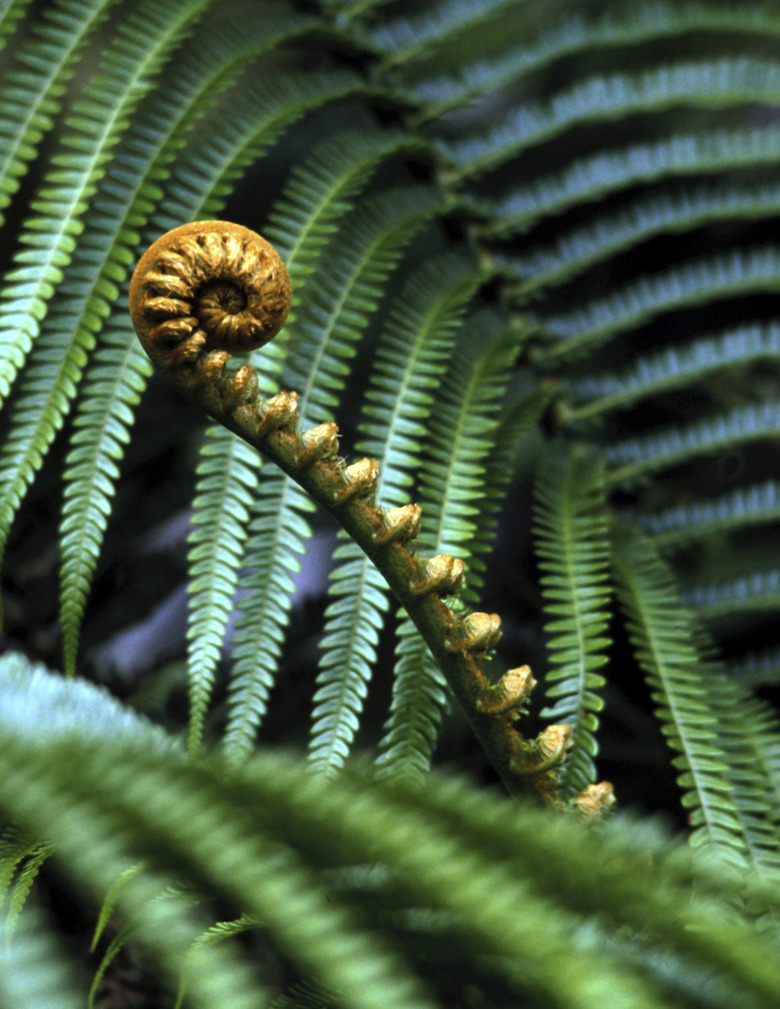Safe Temperature For Outdoor Potted Ferns
Ferns belong to a large division of plants, Pteridophyta, which includes more than 9,000 species of ferns, according to "Encyclopedia Britannica." All ferns share some commonalities, including their unusual way of reproducing via tiny spores that are usually located on the undersides of the fronds. It's these fronds, which drape attractively over the edges of pots, that make ferns an excellent choice for container plants whether sitting on patio tables or hanging from eaves. Safe temperatures for outdoor potted ferns vary widely with the species.
Step 1
Ferns are desirable foliage plants. Many are evergreen, which means they keep their color year-round, and ferns are rarely plagued by insect pests or diseases. This diverse group of plants ranges from ferns found in the cold forests of Alaska to the tropical rain forests of the Amazon. In general, ferns that can tolerate temperatures close to freezing and below are classified as hardy ferns, while those that cannot are called tropical ferns. Ferns are found in U.S. Department of Agriculture plant hardiness zones 2 through 12. So the safe temperature for your outdoor potted ferns depends in large part on where you live and what kind of ferns you have.
How Low Can You Go
Step 1
Hardy ferns are generally tough. Many can survive cold and hot temperatures. If you live in any of the USDA zones 2 through 9, and you are growing hardy ferns, most will probably be fine outdoors in whatever temperatures your climate throws at you. On the coldest end of the scale, hardy ferns can survive temperatures down to minus 50 degrees Fahrenheit. However, hardy ferns in USDA zones 2 through 6, tend to be semi-evergreen. In most cases, it is safe to leave many hardy ferns outdoors all winter long. A few, however, are only cold-hardy to USDA zones 6 or 7. In that case, they are only safe outdoors in temperatures as low as 5 degrees below zero Fahrenheit for USDA zone 6, and zero degrees Fahrenheit for USDA zone 7. The majority of tropical ferns are not cold-hardy below USDA zone 10, which has average maximum low temperatures of just above freezing. Many tropical ferns will die from exposure to freezing temperatures if those temperatures are prolonged. If you are growing a tropical fern in your pot, chances are it won't be safe if winter temperatures drop below freezing. In that case, your choice is to move the pot indoors, cover it outdoors or let the fern die and replace it next year with a hardy fern.
Step 2
- Ferns are desirable foliage plants.
- In general, ferns that can tolerate temperatures close to freezing and below are classified as hardy ferns, while those that cannot are called tropical ferns.
Cold-Loving Choices
Step 1
The only way to find out for sure what temperatures are safe for your potted fern is to identify your fern. If you live in a temperate climate in the West, you might have a western sword fern (Polystichum munitum) in your pot — and if not in your pot, probably somewhere else in your garden. This common fern thrives in USDA zones 3 through 8 and requires almost no maintenance, according to "Fine Gardening." Or, if you live in the North, maybe you are cultivating a Christmas fern (Polystichum acrostichoides), which is hardy in USDA zones 3 through 9 and tolerates just about everything — including deer, rabbits and poor soil.
Step 2
Heat-Loving Choices
Step 1
Tropical ferns aren't just for outdoor gardeners — they are often cultivated indoors as well due to their low tolerance of cold temperatures. One popular tropical choice is "Bostoniensis" (Nephrolepis exaltata "Bostoniensis"), commonly known as the Boston fern and prized for its very long fronds and ease of care. The Boston fern is hardy outdoors in USDA zone 10 through 12 only, which means it is only safe outdoors in temperatures down to just above freezing. The Rabbit's foot fern (Davallia fejeensis) is a good choice for hanging pots — fuzzy rhizomes dangle over the edge, and it's also a low-maintenance fern. The rabbit's foot fern is hardy in USDA zones 10 through 12. Like many other tropical ferns, it can only withstand low temperatures of between 30 and 35 degrees Fahrenheit.
Step 2
- The only way to find out for sure what temperatures are safe for your potted fern is to identify your fern.
- Or, if you live in the North, maybe you are cultivating a Christmas fern (Polystichum acrostichoides), which is hardy in USDA zones 3 through 9 and tolerates just about everything — including deer, rabbits and poor soil.
References
- Hardy Fern Foundation: Cultural Information
- Clemson Cooperative Extension: Hardy Ferns
- Fine Gardening: Polystichum Munitum (Western Sword Fern)
- U.S. Department of Agriculture: Hardiness Zones Map
- University of Minnesota Extension Service: Growing Tropical Ferns Indoors
- Missouri Botanical Garden: Polystichum Acrostichoides
- Missouri Botanical Garden: Davallia Fejeensis
- Encyclopedia Brittanica: Fern
